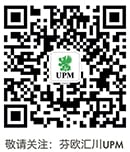Underfoot there are leaves, moss, small branches, morning damp and soft forest floor. Above our heads, the tops of beeches, pines and one of the mightiest lime trees in the Siebentisch forest. The only noise is the rustle of leaves in the wind. “Woofff!” The low but impatient bark of a dog breaks the silence.
Christian Ripperger, forester and forest ranger for the city of Augsburg, pulls briefly on the leash of his Wirehaired Pointer. Frodo lays down again and Ripperger says in a soft voice and with a Bavarian rolled R: “This lime tree here, it is one of the oldest specimens in our city forest. It must have been here for over 200 years ...” He pauses for a moment before continuing “... and it will stand here for a long time to come. It’s a kind of cultural monument, and also a biotope tree - and it's been through an amazing amount in these woods.”
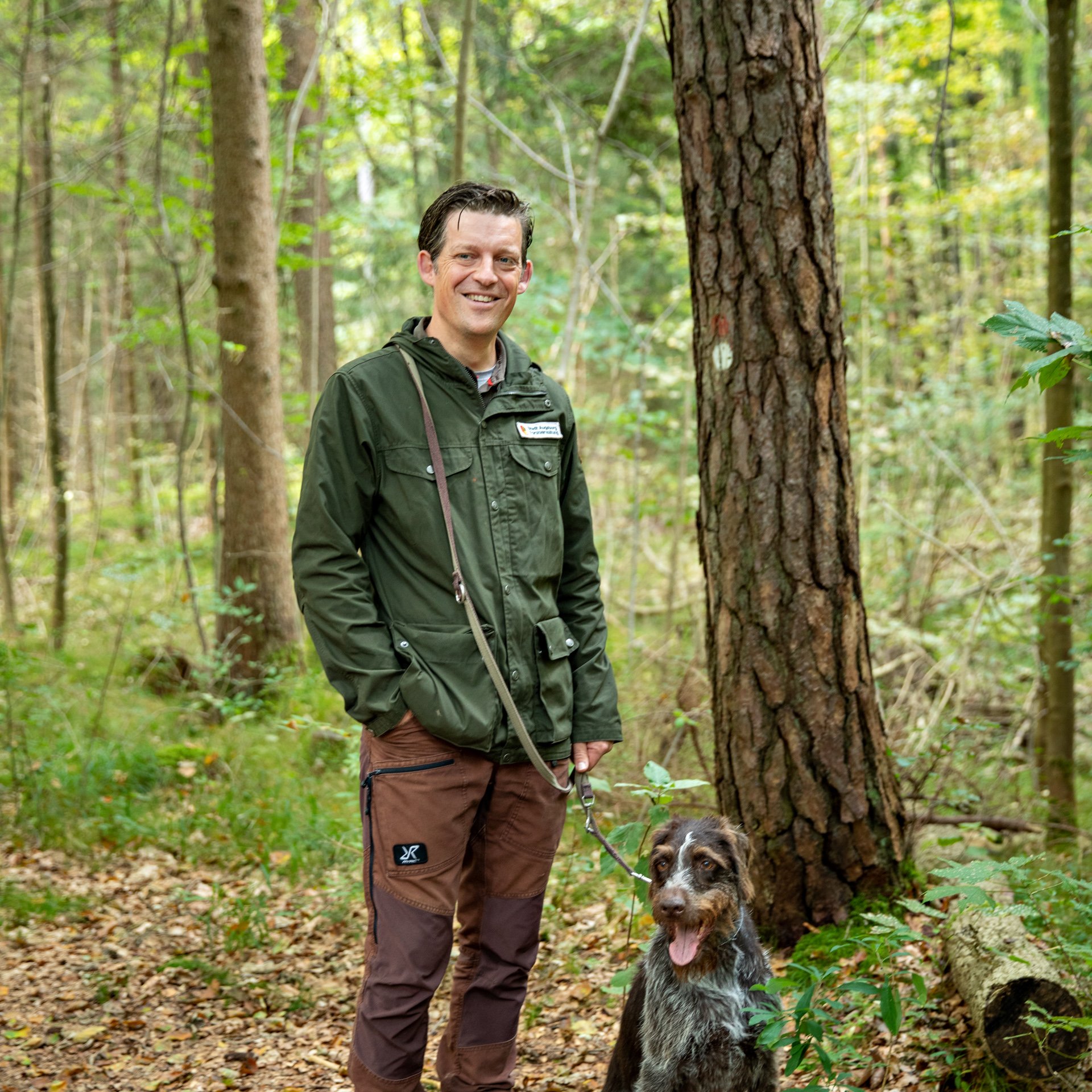
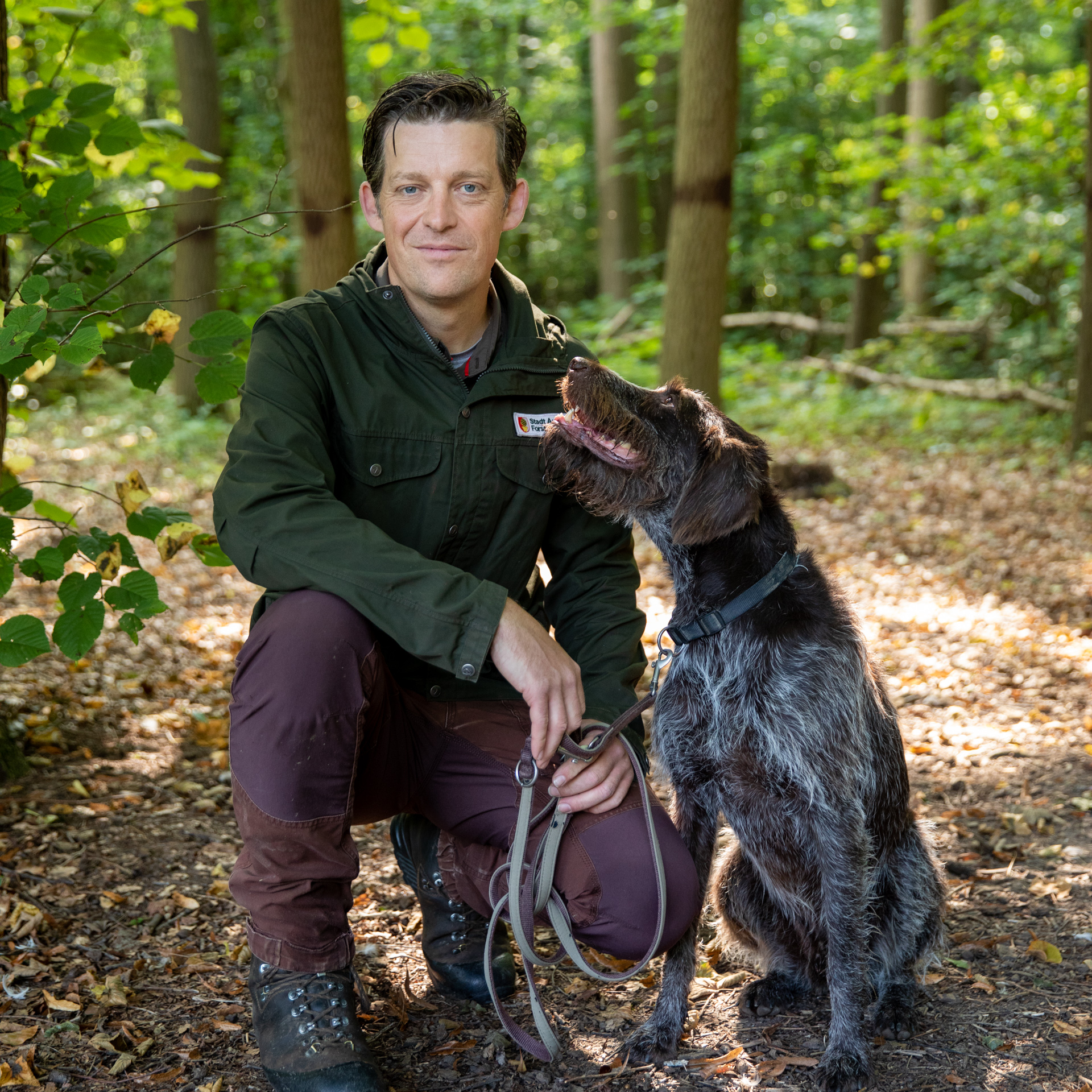 Christian Ripperger, forester and forest district manager for the city of Augsburg, with his dog Frodo.
Christian Ripperger, forester and forest district manager for the city of Augsburg, with his dog Frodo.
For a moment, Stefanie Eichiner puts her hand on the roughly one-meter-thick trunk of the lime tree and looks up at the crown. She has a degree in forestry and is head of the sustainability department at UPM Communication Papers. For her and Christian Ripperger, Bavarian forests are both a profession and a vocation, a place of work and recreation.
They both know how worthy of protection are not only beautiful individual trees like this old lime tree, but the entire ecosystem. Both understand the forestry mistakes of the past due to softwood monocultures, the challenges posed by the climate crisis and the different social interests that come together in the forest. Both also share some forest humour (“If you want to destroy a forest, plant spruce, spruce, spruce”). But the greatest common ground is that they both work on solutions that benefit one thing above all: the forest itself.
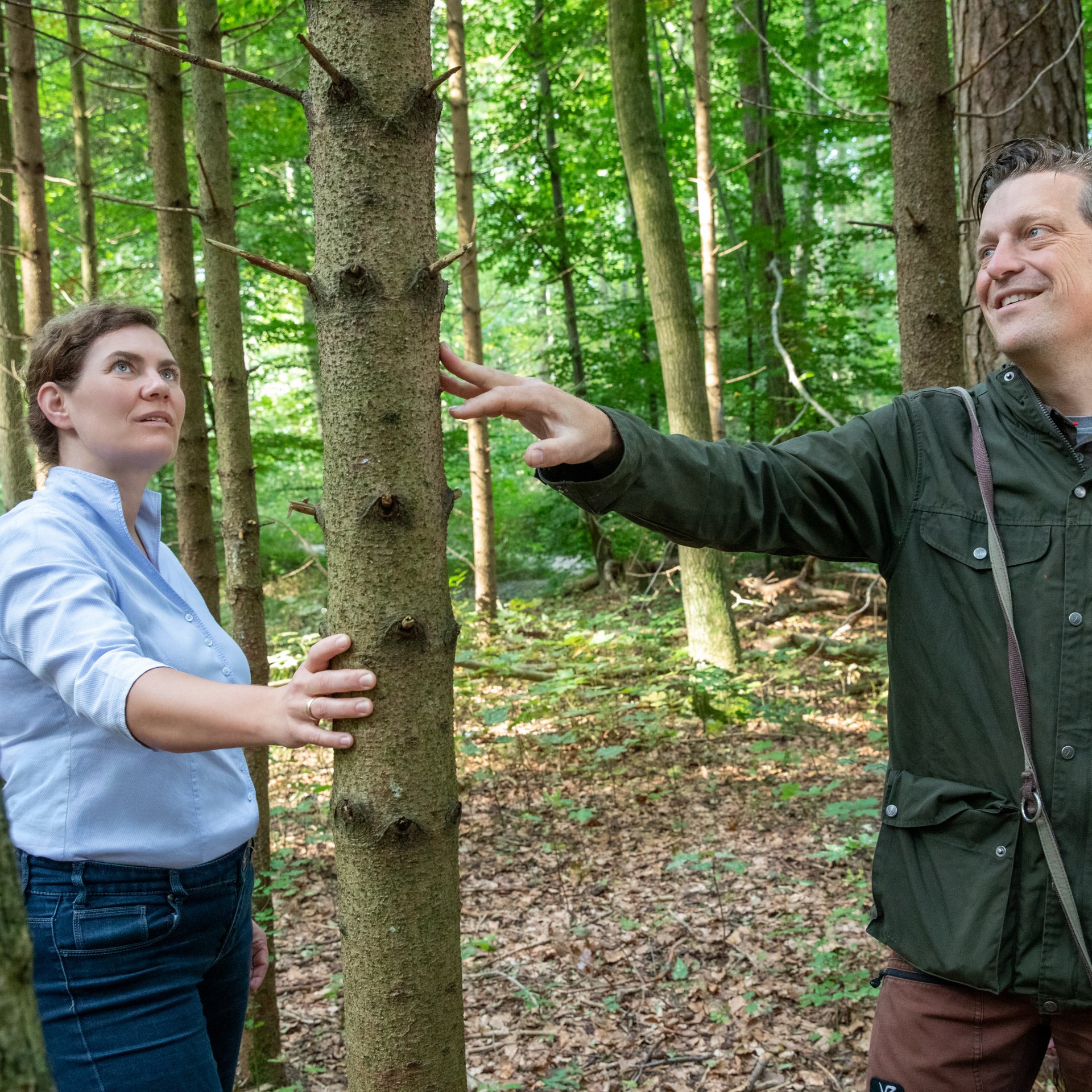
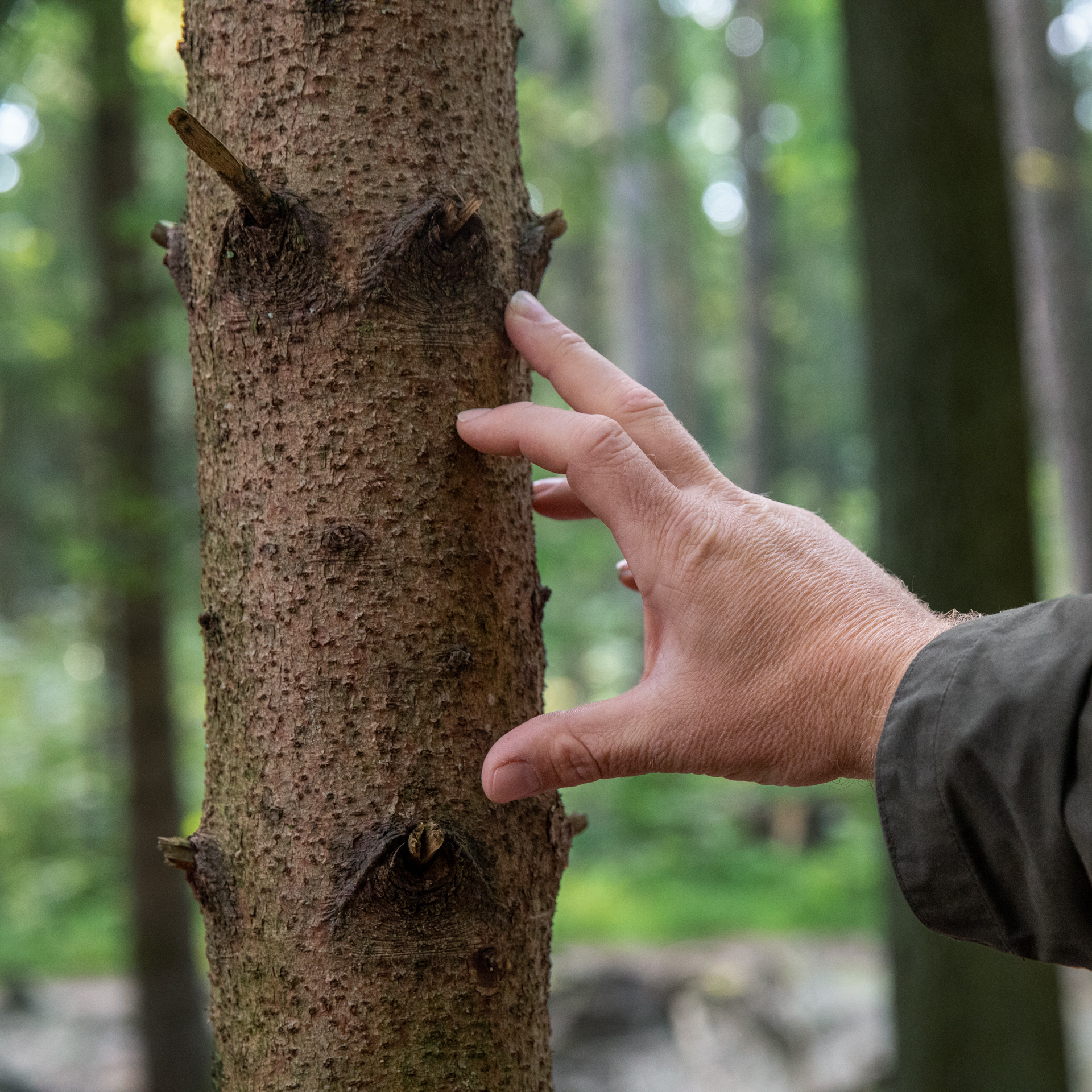 Assessment of the annual growth: Stefanie Eichiner, senior sustainability manager at UPM Communication Papers, and Christian Ripperger, forester and forest district manager for the city of Augsburg.
Assessment of the annual growth: Stefanie Eichiner, senior sustainability manager at UPM Communication Papers, and Christian Ripperger, forester and forest district manager for the city of Augsburg.
Intensive and sustainable forest use
Augsburg’s municipal forest covers a total of 21.5 square kilometres, and is a very good example of sustainable forestry in a highly complex environment. Complex because this forest has many functions. The Siebentischwald is an area of the forest right on the edge of the city. “The forest is not only a recreational area, a supplier of the wonderful raw material wood and protects our drinking water, but also provides several other so-called ecosystem services. Here in the urban forest, up to 13 of these services have been empirically determined", says forester Ripperger. “You can hardly use a forest more intensively, which makes sustainable care and management all the more important. Here, thoughtful action is called for.”
But it’s also striking that you don't see what you might have expected: tall piles of recently felled trees that will later become paper are not found in this part of the forest. “Many people have the idea that entire forests are cut down for us, leaving bare open spaces. This is definitely not the case in Central Europe,” says UPM Sustainability Manager Stefanie Eichiner. “What is delivered to the company is what has fallen for us: paper wood is a by-product. No trees are planted in plantations and later harvested in one fell swoop.” Forester Ripperger adds, "We Forestry people refer to this as thinning material.”
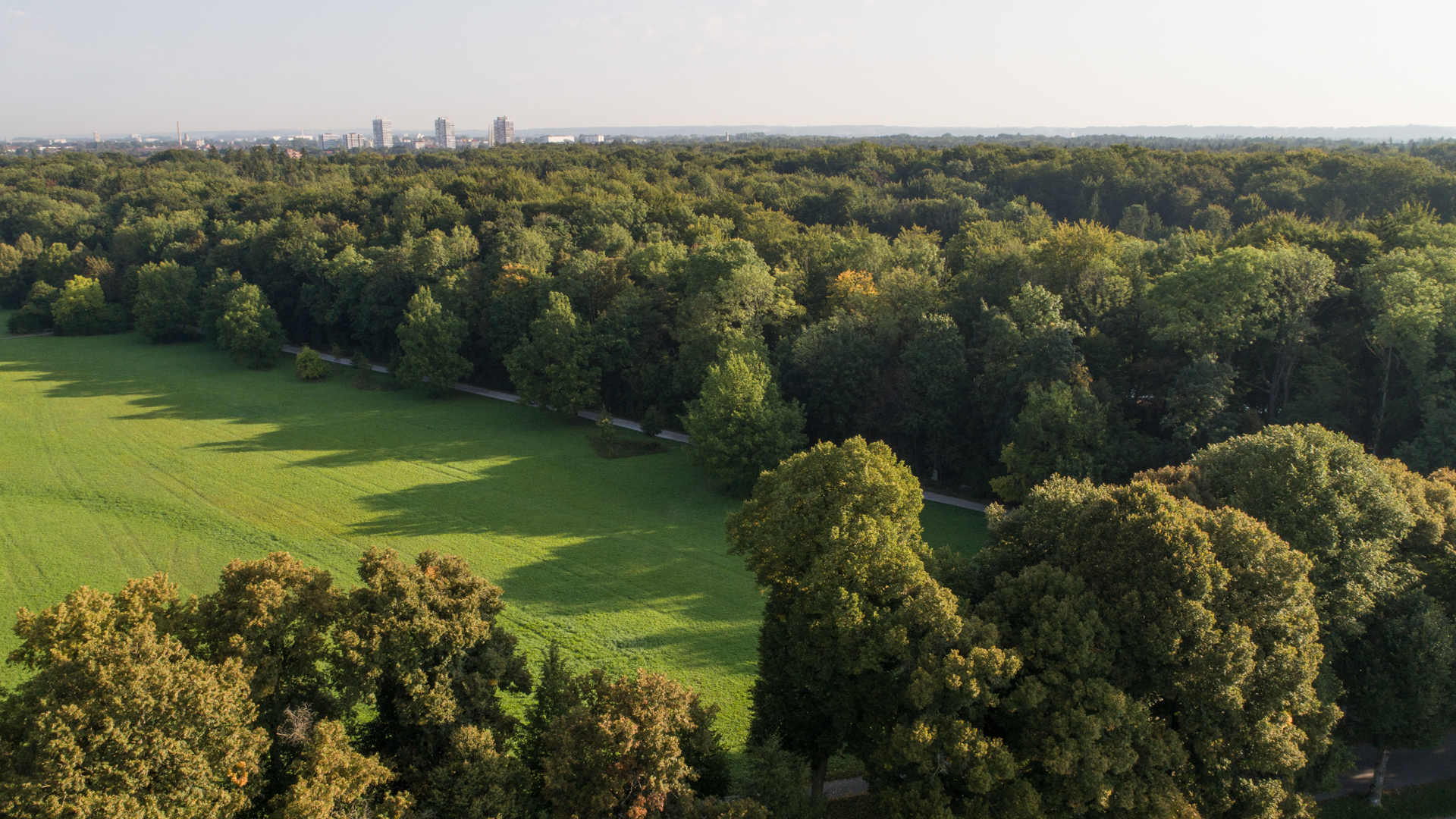
Augsburg on the horizon: The Siebentischwald is a small part of Augsburg's city forest. It is located in the southeast, directly on the outskirts of the city.
Gentle thinning
How does Ripperger find the wood for UPM Communication Papers? “Thinning” is everyday business in forestry; it is also called a “maintenance measure”. To do it, the forester roams his territory, keeping a special eye on growth and the incidence of light – and then decides where to help the forest. Using colourful chalk paint, he primarily marks dead, weak and misgrown trees that loggers will harvest later. By “controlling the light,” Ripperger ensures that the forest is always rejuvenated and that there are never any open areas.
Exactly how this thinning is done varies from forest to forest and depends on the objective. “An overriding goal here in Augsburg’s municipal forest is to convert it to a mixed forest in the long term,” says Ripperger. There are many reasons for this conversion. For example, the proportion of spruces and pines is currently too high, which weakens the forest in the face of climate change and is not good for drinking water quality. All the fallen needles acidify the soil. A mixed forest with a high diversity of tree species is more robust and healthy.
“I don't go into the forest with an order list – ‘5,000 spruce trees with a diameter of 10 centimeters for UPM”
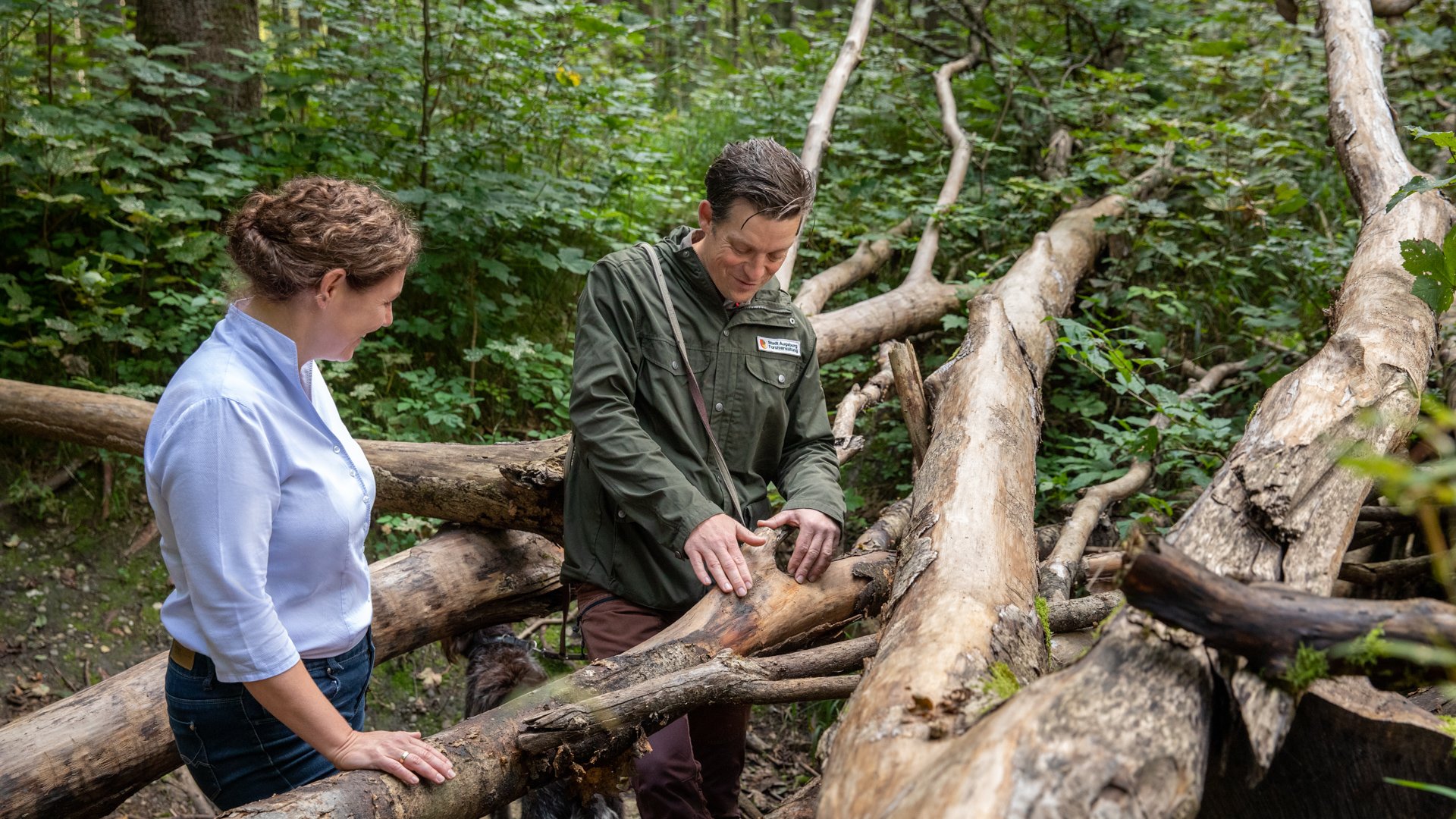
Augsburg's municipal forest is much more than a commercial forest. Large quantities of deadwood that would be sold in other forests remain in this forest and thus become a new habitat, explains city forester Christian Ripperger.
“So I don't go into the forest with an order list – ‘5,000 spruce trees with a diameter of 10 centimeters for UPM’ – and pick them out in one day with the machine. That happens throughout the year and very carefully.” Stefanie Eichiner adds, “The trees for the paper industry are also a by-product of forestry. Trees that no longer have a chance to grow and are unsuitable for the construction or furniture industries. This is because their wood has to meet stricter requirements; for us as paper manufacturers, smaller trees with a smaller girth are sufficient.”
Three dimensions of sustainability
But even if it is only thinning material, this paper wood has a value – especially in Augsburg. Although this is a city-owned forest, the profits do not flow mainly into the city coffers. Christian Ripperger: “Some 83 per cent is what’s known as former endowment forest. This means that, to date, 83 cents of every euro we generate goes to the municipal foundation office and thus benefits social and cultural causes.”
So the money UPM pays for the wood from the municipal forest again indirectly benefits everyone in the region. “Sustainability has three dimensions: economic, ecological and social,” says Stefanie Eichiner. “Here in Augsburg, all three fields are closely intertwined and reinforce each other: the better people care for the forest, the better it cares for them.”
The UPM Augsburg paper mill on the outskirts of the city is also economically significant for the people of Augsburg. It was founded in 1849 and has long been an important employer in the region. Today, some 300 employees annually produce up to 350,000 tons of coated web-fed printing paper, which is primarily used for magazines, newspaper supplements, advertising brochures, and sales and mail-order catalogues. “The short delivery routes between the forest and the mill contribute to our very good environmental balance at the site,” says Eichiner.
Forest and paper as carbon sinks
Stefanie Eichiner and Christian Ripperger stop for a moment next to a large beech tree. A question that both the urban forester and the UPM sustainability expert are often asked is, “Why don’t you just let the forest grow?” As simple as the question seems, the answer is complex. “The question suggests we are talking about virgin forests. But there are no virgin forests left in Europe. Humankind has been managing forests for hundreds of years and using wood as a material for building, heating or cooking.
...more CO2 is pulled from the atmosphere by these young trees, which are still growing.
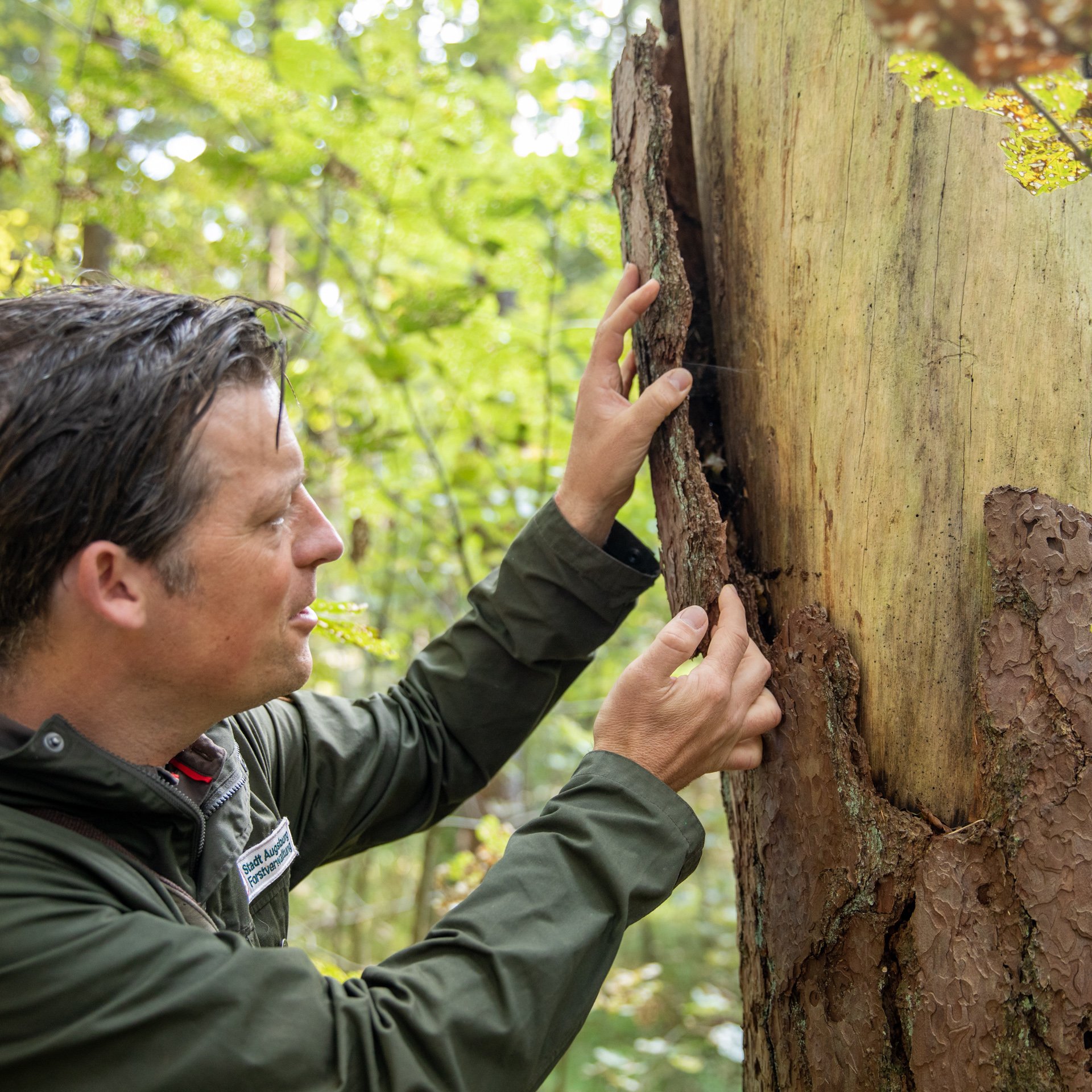
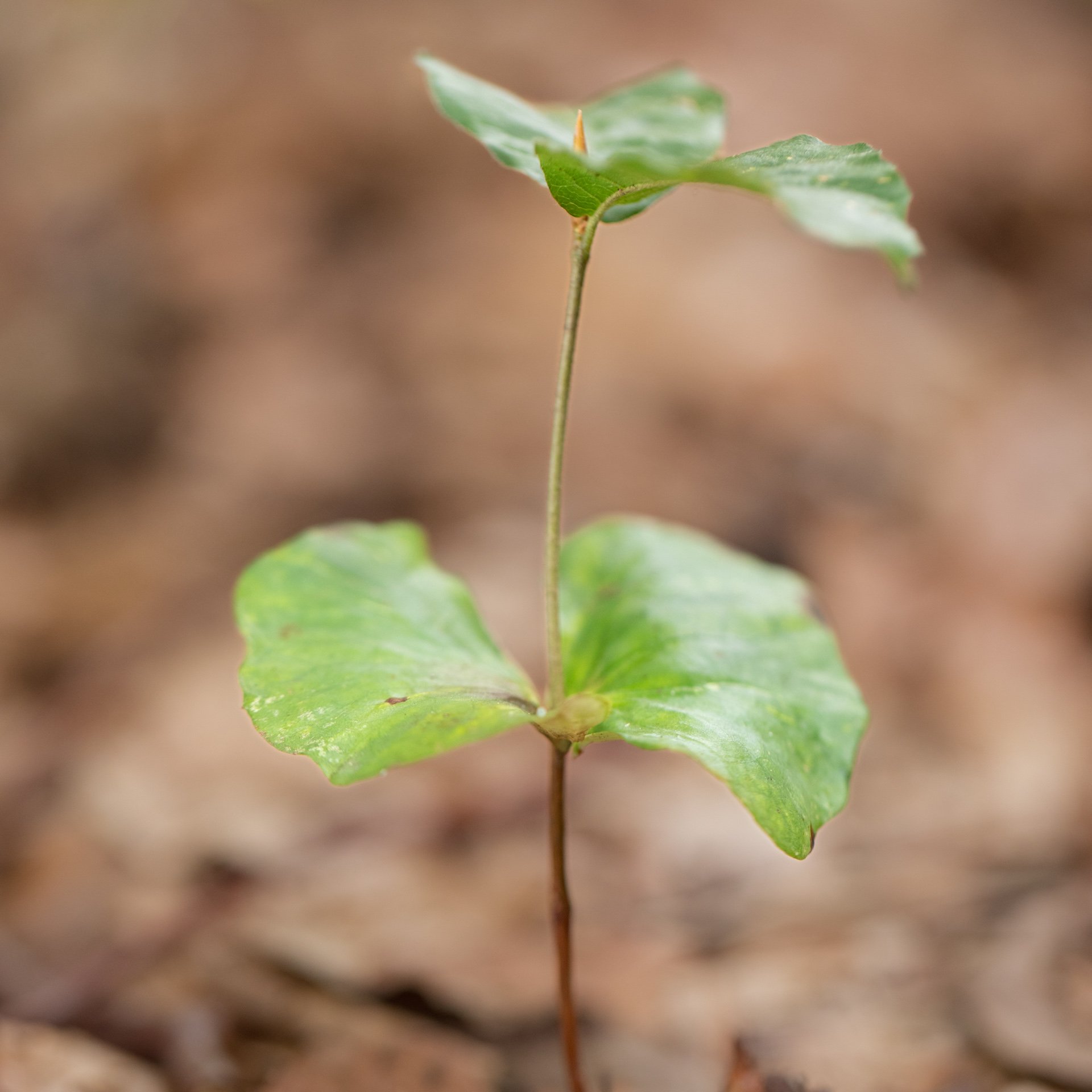
Left: A healthy forest is all about the details: Forester Christian Ripperger looks behind the bark of a dead tree that is not harvested but remains in the forest. Right: Young and worth protecting: sapling in Augsburg's city forest. The more than three million visitors to the forest each year are called upon to move carefully in nature.
All the forests in Europe are man-made,” says Eichiner. “And in times of climate crisis, we need to do that even more strategically,” adds Ripperger. Why? “Such a large, mature tree binds a lot of carbon, but has also reached its maximum mass. But more CO2 is pulled from the atmosphere by these young trees, which are still growing.” Ripperger points to three young beeches, each about five meters tall – but they are in the shade of a large and mature beech. “If we eventually cut down the mature beech,” says Ripperger, “the three young birches will have better conditions to grow faster – capturing more CO2 from the atmosphere overall.”
Sustainably managed forests have a better climate balance than wild forests due to their greater wood growth. In this way, the forest becomes a CO2 sink. “It sounds logical, but there is a small catch," adds the forester. “The important thing is that, in our case, we’re putting the wood from the mature beech to a long-term use.” What does that mean? If people use the wood for a durable piece of furniture, for example, the stored CO2 is expected to be bound there in this function for more than a hundred years.
Wood as a raw material also fulfills its function as a CO2 sink when processed into paper: paper grades such as UPM Fine, for example, can easily be archived for 30 years and bind 297 kg of CO2 from the atmosphere for every ton. Stefanie Eichiner: “If our paper is recycled afterwards, it effortlessly remains in a closed cycle for further decades.” Burning this wood, on the other hand, would be bad for the climate. Although it would save crude oil or natural gas and leave it in the ground, it would immediately destroy the wood’s carbon storage capacity.
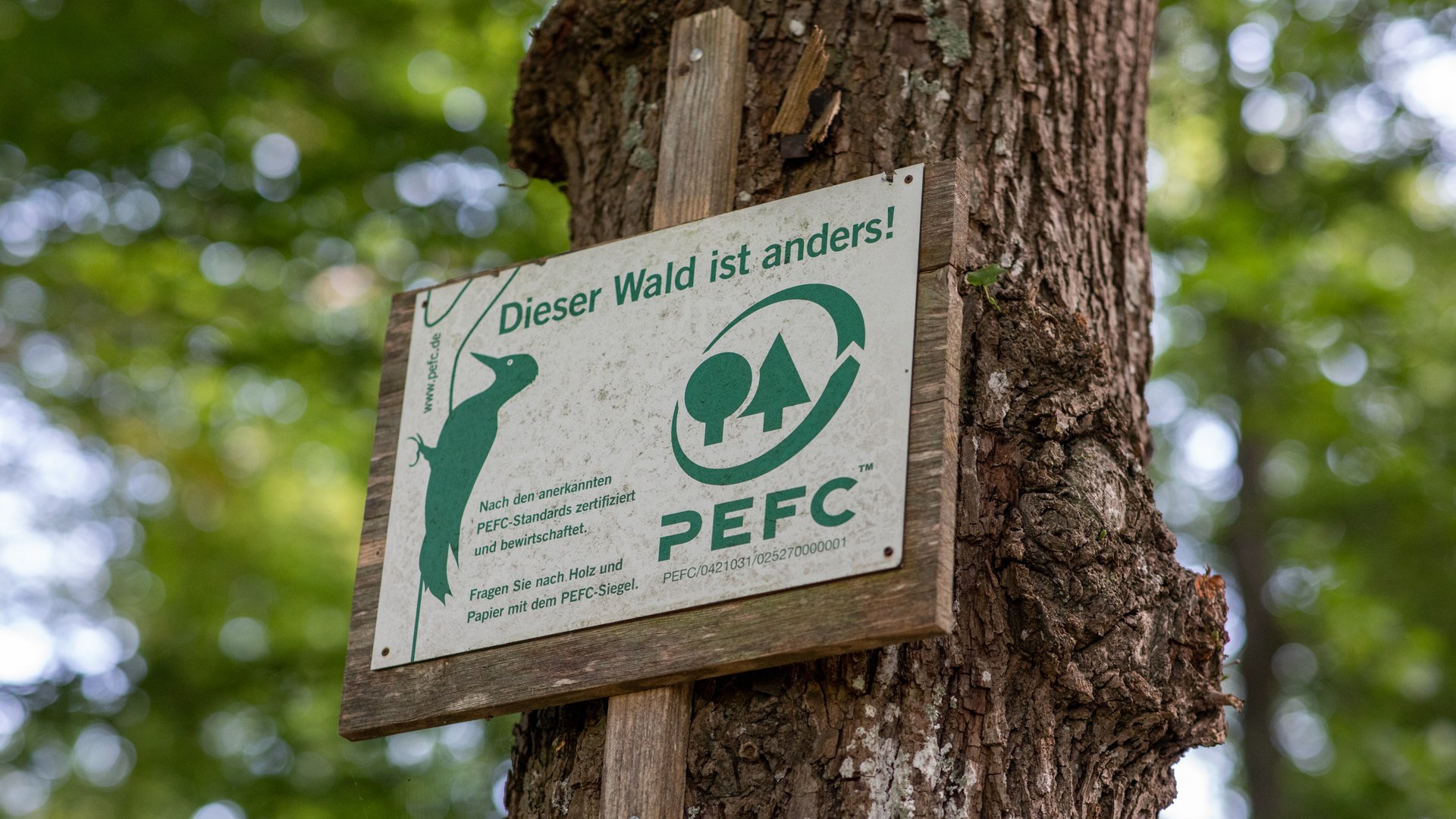
Augsburg's municipal forest is managed more sustainably than many forests in Germany. This is also certified by one of the world's largest forest protection organisations PEFC (Programme for the Endorsement of Forest Certification Schemes).
So the concept of “long-termism” is another major common feature in the work of Stefanie Eichiner and Christian Ripperger. “In Augsburg's municipal forest, we plan in time frames of a hundred years,” says the forester. “That's why we’re now creating stable mixed forests – with climate-sensitive, site-appropriate tree species – to survive crises, whether caused by fungi, beetles or periods of heat.” And UPM? “Our business model is based on wood from sustainable forests,” says Stefanie Eichiner. “Responsible sourcing of raw materials is mandatory for us. In the Augsburg municipal forest, you can see how this works with the right strategies, even in complex systems.”
Text: Sven Schulte-Rummel
Photos: Marek Vogel
